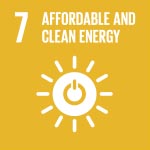CAP strives to reduce its environmental impact through and efficient use of energy and the incorporation of new energy sources and clean technologies from the very design stage of its projects.

By the end of 2017, during the UN Climate Conference, a group of researchers from 57 countries disclosed a study stating that, in the past year and after a 3-year stability period, GHG emissions had increased again up to maximum historical levels. This revelation caused the UN Secretary General to prompt all countries of the world to redouble their efforts in the fight against global warming, as the cause of floods, droughts, food shortage and natural disasters in large areas of the planet.
In order to join this world challenge, in the past decade Chile has put in place a number of policies and initiatives destined to advance, given the special conditions of our country, the use of NCRE as the foundations of the national energy matrix and, together with the private sector, build an increasingly carbon-free economy.
These efforts are part of the National Energy Strategy mapped out by the authorities to 2050, and involve specific goals and commitments, such as the progressive reduction of GHG and energy consumption, especially by large mining, industrial and transport companies.
Even when these initiatives have allowed Chile to become a leader in this area, they have failed to keep our territory free from global-scale climate change, already causing a serious water drought, average temperature increase and a notable reduction of rainfall in the Norte Grande and central valley regions.
In this sense, the CAP Group reiterates its commitment to advocate the use of NCRE and to promote the incorporation of systems and technologies that guarantee the efficient use of water and energy in all its operations.
Impact mitigation
The encroachment of climate change in recent years has translated into a tangible disruption of the way that CAP operations used to develop their activities. In 2017, for example, CAP Minería operations were seriously affected by the heavy rain and wave surges occurred in the Atacama region seacoast. Phenomena like these have led the company to raise the need to formulate new management standards to address these climate concerns.
In broader terms, large-sized national companies operation in the north of Chile in the last decade have felt the effects of climate change in the form of progressive hydric deficit and the increasing prices of energy costs.
Most CAP companies have developed mitigation and adaptation programs designed to reduce the impact of these climate challenges. These aids promote the inclusion of NCRE in the energy matrix of their operations as well as emission measurements and monitoring.
As for the use of clean energies, solar energy has been incorporated into CAP Minería Cerro Negro Norte deposit processes while the participation of NCRE within the national energy matrix, that feeds CAP Acero, continued to increase in 2017.
On the other hand, Cintac Maipu completed the construction of the largest rooftop solar plant in the Southern Cone. The energy generated by this photovoltaic station will feed the company’s consumption needs from 2018; thus, its impact on emission reduction will be reflected on the 2019 carbon footprint.
Also in 2017, Cintac ceased to use 141B as blowing agent in the manufacturing of polyurethane-insulation boards. This is an ozone-depleting gas and its eradication equates to a reduction of 2.87 ODP tons (Ozone Depletion Potential).
This is a major contribution to the country’s goals, given that the maximum import volume of this substance permitted for 2018 is 76 tons.
Additionally, Cintac started the pilot version of its Live Filter project, an innovative and sustainable initiative designed to reduce particulate material, especially, in emergency and pre-emergency periods. Basically, the emissions are channeled to a dirt substrate where they are absorbed and turned into nutrients for the plants that are also part of the filter.
CAP Acero, Cintac and TASA are the CAP Group operations committed to measuring their carbon footprints on a yearly basis.
CAP Acero reports its emissions inventory to the World Steel Association while Cintac follows the Huella Chile methodology. In December 2017, the Ministry of the Environment and its Huella Chile program recognized Cintac for their quantification and verification of the corporate carbon footprint.
With respect to projects under development, the Cruz Grande port represents a project the company is pursuing to build at La Higuera commune, Coquimbo region. It will consist of a mining port terminal large enough to handle bulk carriers of up to 300,000 DWT and its Environmental Impact Assessment was approved in 2015.
These facilities, located near the old El Tofo deposit operated by CAP until 1974, whose contiguous communities have maintained historical relationships with the company for nearly six decades, were designed from the very beginning with all the necessary protections to minimize any possible environmental or social adverse externality.
| Acero | Cintac1 | ||||||
|---|---|---|---|---|---|---|---|
| 2015 | 2016 | 2017 | 2015 | 2016 | 2017 | ||
| Scope 1 – Ton of equivalent CO2 | Not measured | Not measured | 1,547 | 2,210 | |||
| Scope 2 – Ton of equivalent CO2 | 2,811 | 3,718 | |||||
| Scope 3 – Ton of equivalent CO2 | 341,945 | 524,378 | |||||
| Emission intensity – Tons of equivalent CO2 / produced ton | 2.2 | 2.1 | 2.12 | 5,975 | Not measured | ||
| 1 Carbon footprint indicators are higher than the previous year as Matalcón and Lonquen plant were, for the first time, included in the measurement process. Scope 1: Direct emissions resulting from the production process. Scope 2: Indirect emissions resulting from the consumption of purchased energy. Scope 3: Indirect emissions resulting from third-party activities. |
|||||||
In spite of the above, climate change is not only a synonym of risks and challenges for the company but it has turned out to be a key agent of innovation and continuous improvement as well as a source of value creation and new businesses. Below are some of the sustainable systems, products and services developed by the company:
Achieving a more efficient energy consumption per unit produced is a specific goal pledged by the CAP Group management. To this end, in 2016 the company started to work out a plan containing actions and programs for each of its affiliates. In 2017, this effort turned into the following initiatives and developments:
CAP Minería
Main energy sources: Fuel (oil) and electric power.
Most energy efficiency initiatives promoted by CAP Minería are consistent with the goals and commitments presented in the annual energy efficiency plans for the operations certified under the ISO 50001 standard.
Since late 2017, Los Colorados mine and Magnetita plant operate under this management system. Thus, both these facilities have in place an energy efficiency policy through which they commit to optimizing their productive processes and activities, with a view to continuous improvement in energy aspects.
To this end, during the year the operations conducted a baseline assessment and mapping of their total consumptions and critical equipment consumption.
Recertifying Los Colorados mine and the Magnetita plant under the ISO 50001 standard and certifying the pellet plant, Punta Totoralillo port and Cerro Negro Norte under this same standard stand as one of the challenges to be addressed by this affiliate in energy matters during 2018.
CAP Acero
Main energy sources: coal and electric power.
The steelworks completed the implementation of its Energy Management System based on the ISO 50001 standard and successfully passed the audit required to obtain the certification during 2018.
Additionally, 2017 was the first time the company had to deal with the green tax*.
Based on its interest to optimize the energy efficiency levels across its operations, the implementation of this green tax was seen by the company as an opportunity to enhance energy performance at plant level.
Thus, and with the purpose of exempting itself from this levy, the company invested on equipment especially designed to reduce steam consumption in order to reduce the installed capacity of thermal megawatts.
Also in 2017, CAP Acero was awarded the Energy Efficiency Seal, Silver category, in recognition of its achievements in steam consumption reduction at the coke plant, after completion of the project to change the ammonia-liquor pump motors.
* Green tax: This tax (also known as Pigouvian tax on pollutant emissions) was imposed in 2014 as part of the General Tax Reform Act, though it came in effect only in 2017. It levies directly the emissions from industrial processes due to the environmental damage caused by pollution. It is applied to facilities operating with boilers or turbines and is expected to reduce local and global contamination.
CINTAC, TUPEMESA Y TASA
Main energy sources at Cintac: electric power, diesel oil and natural gas.
In 2017, Cintac gave new momentum to the Energy Efficiency Committee. This collaborative initiative, where representatives from different company areas participate, focused its work on the analysis of energy consumption statistics between 2016 and 2017 with the purpose of defining efficiency initiatives and consumption targets for 2018.
As one the measures taken, the committee decided to eliminate a steam industrial boiler from the Lonquen plant powered by bulk gas. Instead, the company will use the paint furnace gases for coil cleaning purposes.
Additionally, the Energy Efficiency Committee addressed other issues, such as the possibility of certifying Cintac under the 50.001 standard, a project under ongoing evaluation.
| Minería | Acero | Processing1 | New Businesses2 | ||||||||||
|---|---|---|---|---|---|---|---|---|---|---|---|---|---|
| 2015 | 2016 | 2017 | 2015 | 2016 | 2017 | 2015 | 2016 | 2017 | 2015 | 2016 | 2017 | ||
| Total energy consumed in GJ | 6,809,900 | 6,378,775 | 7,162,788 | 18,407,535 | 19,093,761 | 19,182,803 | 33,660 | 68,751 | 83,249 | 260,161 | 295,355 | 263,967 | |
| Electric power consumed in GJ | 2,583,238 | 2,240,312 | 3,007,082 | 1,333,843 | 1,322,881 | 1,362,720 | 33,660 | 34,229 | 38,613 | 260,161 | 291,549 | 260,664 | |
| Electric power consumed in GJ / ton produced | 0.17 | 0.14 | 0.19 | 1.72 | 1.62 | 1.9 | 0.16 | 0.19 | 0.12 | 0.01 | 0.01 | n.i | |
| Fuel | |||||||||||||
| Fuel consumed in GJ | 4,226,662 | 4,138,463 | 4,155,706 | 17,073,692 | 17,770,880 | 17,820,083 | n.i. | 34,522 | 44,635 | n.i. | 3,806 | 3,303 | |
| Fuel from non-renewable sources | 4,226,662 | 4,138,463 | 4,155,706 | 17,073,692 | 17,770,880 | 17,820,083 | n.i. | 34,522 | 44,635 | n.i. | 3,806 | 3,303 | |
| Fuel from renewable sources | 0 | 0 | 0 | 0 | 0 | 0 | n.i | 0 | 0 | n.i | 0 | 0 | |
| 1 Processing figures include only Cintac. The value of total energy in 2015 covers only electric power consumption. For the year 2017, the sum of total fuel consumption plus electrical energy does not give the total reported as total energy consumed since part of the fuel (8,817 GJ) was not used to produce energy. 2 New Businesses figures only include the desalination plant. The values of total energy in 2015 cover only electric power consumptions. |
|||||||||||||

OPINION
PIECE
Javier Romero M.
"At the Base of
Sustainability
Development"
A tendency that has emerged as a result of globalization is the search of strategies designed to achieve improvement processes that eventually become of key importance to increase both production and productivity.
Therefore, and considering our rapidly evolving context, innovation turns out to be the main tool capable of guaranteeing a company’s importance and position in the market.
Striking a balance between technology, talent, process management and sustainability stands as the greatest challenge encountered in our efforts to generate new business opportunities. However, innovation has been entrusted as the source of competitive advantages that will drive companies into creating sustainable value.
No doubt, environmental protection is a core concern for the industrial activity development. Since climate change represents a worldwide issue, the innovation and modernization of existing technologies plays a key role both locally and globally.
Considering the above, innovation must be deemed as an interactive process where companies, apart from acquiring knowledge through their own experience, must be in a constant process of learning about their relationship with external (clients, suppliers, institutions and communities) and internal (collaborators) sources.
With regard to Cintac, innovation is ingrained in the DNA of our company and this process has run parallel with an organizational cultural change where the focus has been placed on people. This strategic change is clearly reflected on the development of human talent, with a special interest in generating formal training opportunities.
We must bear in mind that companies, rather than being only an employment source, they should operate as magnets to attract new talents, promoting creativity and the development of the necessary competencies to fulfill the desired objectives.
Furthermore, the creation of multifunctional teams becomes especially important. Historically, Cintac has been a metallurgical company; however, and due to that new vision, we have invited professionals from different fields to join us. Thus, we have welcomed agricultural engineers, architects, psychologists, designers and journalists.
This diversity has enabled us to execute a synergic work, a very important element at design, production and later commercialization stages that will also project us into the future as an attractive, innovative and sustainable organization.
Nowadays, companies are faced with the challenge of process innovation and the creation of solutions to their clients’ dilemmas. This is an ongoing task with more than one destination point. Therefore, a methodology should be generated to keep it going over time and thus successfully achieve sustainability and innovation, two closely related factors.

Javier Romero M.
Chief Executive Officer (CEO), Cintac S.A.

